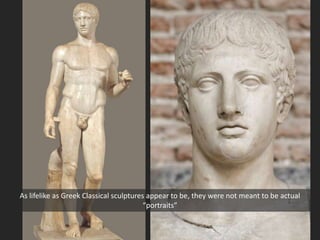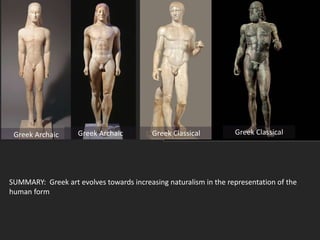These relief sculptures are known for their dynamic movement and realism and decorated the temple chambers interior walls. Can be seen on the Temple of Athena Nike built on the Acropolis between 427 and 424 BCE.
1 reflecting the hope for an enjoyable existence in the afterlife with a youthful body of harmonious proportions and natural beauty the features unlined but pleasant and full of vigor.

. Were classical sculpture naturalistic and idealistic. Classical Greek figures appear more relaxed than the rigid formal Egyptian and early Greek sculptural poses because _____. For details of art movements.
This sculpture and other reliefs of this time have influenced later artists like Auguste Rodin. Classical Greek sculptors were more imaginative because the Enlightenment released them from the dogma of the pharoahs. Classical Roman art differed from classical Greek art because Roman art focused on realism while Greek art focused on idealism.
The naturalism also idealism in art is a flow of about 1870 to 1890 in the broadest sense. The only materials available to the Egyptian sculptors were stones that had a very. The gener-alization which many of these critics.
Prebles Artforms Ch 15 77 terms. Temples and other public buildings. In the course of its long history Egypt produced a large number of funerary statues both naturalistic and idealizing Fig.
Defined by a careful observation of nature a new concern for the mechanics of the body and the pursuit of ideal forms Classical Greek sculpture represents a radical departure from the compact forms and upright poses of Archaic male nudes. In the visual arts such a tendency manifests itself constantly from time to time taking shape in. The Kritios Boy best represents the classical style in that it is the earliest known use in sculpture of the newly articulated technique in classical Greek sculpture by which the naturalistic weight of the statue is distributed or shifted to one foot is called a.
The Greeks idealized the human form because much of their art was a. Classical sculpture was both naturalistic and idealistic Government assembly halls The first Christian churches were patterned after basilicas used by he Romans as. Beautiful natural looking images of men and idealized images of Gods.
Poses became more naturalistic see the Charioteer of Delphi for an example of the transition to more naturalistic sculpture and the technical skill of Greek sculptors in depicting the human form in a variety of poses greatly increased. In them classical sculpture has been virtually a synonym for Greek and Roman sculpture And certain characteristics of it have been cited in sweeping terms such as generaliza-tion idealism harmony fine propor-tion simplicity dignity clarity sym-metry directness nobility. -major difference completely carved figure in Greek art and much less naturalistic than Egyptian figure Menkaure and a Queen.
The tendency to the most complete and absolutely accurate reflection of reality in all its manifestations details and details. The Classical period saw changes in both the style and function of sculpture. The Hellenistic art looked at how the.
Classical Greek sculpture became increasingly naturalistic and began to show the body as alive and capable of movement while maintaining an interest in portraying the ideal human. Their sculpture was predominantly portraiture see below until from the 1st century AD the Romans adopted Hellenistic sculpture which took sculpture to a different level as a model for their own sculpture. The rigid poses of Egyptian and early Greek figures gave way to a greater interest in anatomy and more relaxed poses.
3 points QUESTION 25 1. The sculptures of this later period are moving away from the Classical characteristics they. After mastering the portrayal of naturalistic bodies from stone Greek sculptors began to experiment with new poses that expanded the repertoire of Greek art.
Were developed in the late fifth century BCE. Difference Between Hellenistic and Classical Art Hellenistic vs Classical Art When talking about Hellenistic and classical art both arts are known for displaying human anatomy. In Hellenistic art one can see that the art forms went beyond understanding human anatomy and looked at how the body moved and how it looked when in action.
Differ from greek sculpture of the high classical period. The Parthenon Marbles created by Phidias are perhaps the most famous examples of this style of Classical Greek sculpture. Prior to the influence of Greek sculpture Roman sculpture was portraiture sculpture busts.
YOU MIGHT ALSO LIKE. Classical Greek sculpture is both naturalistic and idealistic. Their portraiture sculpture is regarded as the best sculpture of.
True or false Classical sculpture was both naturalistic and idealistic. Roman artists typically made realistic portraits and sculptures. Classical sculpture like Discobulus by Myron was both naturalistic and idealistic TF.
By signing up youll get thousands of step-by-step. Played a major role in the daily lives of the people of ancient Greece. Classical art emphasizes rational simplicity order and restrained emotion.
Annibale Carracci 1560-1609 influenced by Federico Barocci1526-1612 and others produced an idealistic naturalism based on Classical models and though he could depict everyday scenes with remarkable truth his world is an idealised one based on the Classical concepts of. Art that was both Naturalistic and idealistic. Classical art that emphasized rational simplicity order and restrained emotion.
From about 500 BC statues began to depict real people.

Classical Greek Sculpture Is Both Naturalistic And Idealistic True Or False Study Com

Form And Reality The Classical Greek Balance Of The Ideal And The Natural Disrecognized Space

On The Literature And Thought Of The German Classical Era 11 Laocoon In Germany Open Book Publishers





0 comments
Post a Comment